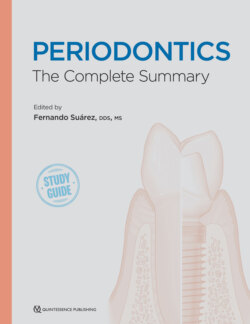Читать книгу Periodontics - Fernando Suarez - Страница 108
На сайте Литреса книга снята с продажи.
Dental Materials and Tooth Position–Related Factors IMPACT OF DENTAL MATERIALS
ОглавлениеThe periodontium can be affected by the different types and surface characteristics (eg, surface free energy and roughness) of dental materials.194–197 In a comparative study by Chan and Weber,198 150 crowns (50 porcelain crowns with aluminum-oxide framework, 68 porcelain-fused-to-metal [PFM] restorations, 13 cast gold crowns, 19 acrylic resin veneer crowns) and 242 intact natural teeth serving as controls were compared in terms of plaque retention using Löe and Silness199 plaque index scores in a crown-to-quadrant ratio. Results showed that crowns with an aluminum-oxide base had minor plaque retention (32%), whereas PFM crowns (90%), natural teeth (110%), cast gold restorations (148%), and acrylic resin veneer crowns (152%) had substantially more plaque retention. Other material surfaces, like lithium disilicate and zirconia, have shown a superior resistance to surface roughness changes after instrumentation with stainless steel curettes, yet zirconia revealed a greater bacterial adhesion compared with gold alloy and lithium disilicate.200
Despite differences in plaque retention and quality of the marginal fit, galvanic-ceramic crowns demonstrated significantly less clinical and inflammatory responses than metallic-ceramic crowns by means of plaque index, gingival index, gingival crevicular fluid flow rate, and levels of immunoglobulin G.201 Nonetheless, these responses might differ when ceramic or metal restorations are compared with resin-bonded restorations. A study by van Dijken and Sjöström tested the effects of glass ionomer cement and composite filling materials for Class V subgingival cervical lesions and demonstrated that these materials present with no differences over time in term of the amount of plaque and degree of gingivitis when compared with enamel.202 Konradsson et al noted a similar inflammatory biomarker response (interleukin [IL] 1α, IL-1β, and IL-1 receptor antagonist) with different materials when compared with enamel.203
It has been proposed that a maximum roughness threshold of Ra less than 0.2 μm be recommended to reduce plaque accumulation.204 Moreover, periodontal therapy might have an impact in roughness changes, resulting in increased plaque accumulation. These changes are also dependent on each dental material and treatment modality.205 An in vitro study using gold alloy specimens showed that pre- and posttreatment Ra values significantly increased after instrumentation with stainless steel curettes and prophylactic cups.200 Interestingly, stainless steel curettes increase roughness levels nearly 13 times greater than prophylactic cups.
Proceedings from the 2017 World Workshop on the classification of Periodontal and Peri-implant Diseases and Conditions concluded that dental materials act similar to enamel as plaque retentive factors to initiate gingivitis.197
